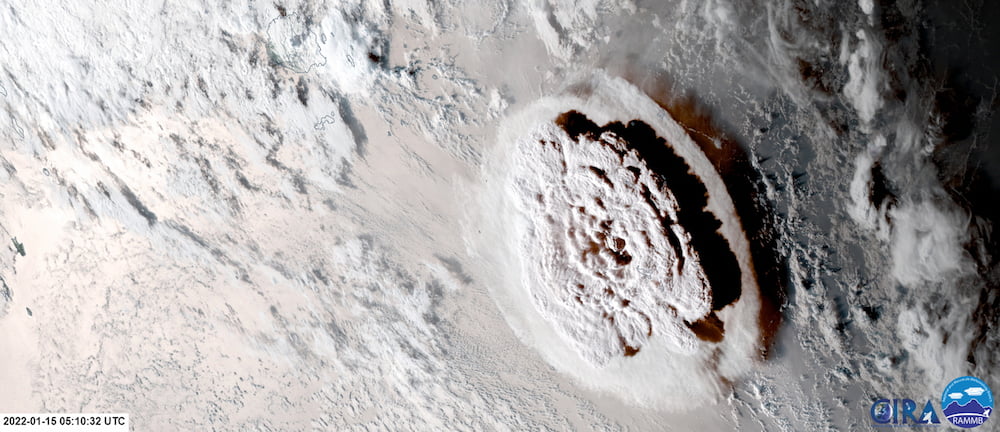An undersea volcano has erupted near Tonga, sending large waves crashing across the shore and people rushing to higher ground.
There were no immediate reports of injuries or the extent of the damage as communications with the small Pacific nation remain problematic.
Video posted to social media on Saturday showed large waves washing ashore in coastal areas, swirling around homes and buildings.
A spokesperson for the Australian government said initial assessments are under way and the Department of Foreign Affairs is working to ensure Australians in Tonga are safe and accounted for.
“Tonga is part of our Pacific family and our thoughts are with the entire community dealing with the impact of the volcanic eruption and tsunami,” the spokesperson said in a statement.
“The Prime Minister and Minister for Foreign Affairs are monitoring the situation and Australia stands ready to provide support to Tonga if requested.”
New Zealand’s military said it was monitoring the situation and remained on standby, ready to assist if asked.
Satellite images showed a huge eruption. The Tonga Meteorological Services said a tsunami warning was in effect for all of Tonga, and data from the Pacific Tsunami Warning Centre showed waves of 80cm had been detected.
Authorities in nearby Fiji and Samoa also issued warnings, telling people to avoid the shoreline due to strong currents and dangerous waves.
The Japan Meteorological Agency said there may be a slight swelling of the water along the Japanese coasts, but it is not expected to cause any damage.
The Islands Business news site reported that a convoy of police and military troops evacuated Tonga’s King Tupou VI from his palace near the shore. He was among the many residents who headed for higher ground.
The explosion of the Hunga Tonga-Hunga Ha’apai volcano was the latest in a series of spectacular eruptions.
A Twitter user identified as Dr Faka’iloatonga Taumoefolau posted video showing waves crashing ashore.
“Can literally hear the volcano eruption, sounds pretty violent,” he wrote, adding in a later post: “Raining ash and tiny pebbles, darkness blanketing the sky.”
Earlier, the Matangi Tonga news site reported that scientists observed massive explosions, thunder and lightning near the volcano after it started erupting early Friday.
The site said satellite images showed a 5km-wide plume of ash, steam and gas rising up into the air to about 20km.
The volcano is located about 64km north of the capital, Nuku’alofa.
Back in late 2014 and early 2015, a series of eruptions in the area created a small new island and disrupted international air travel to the Pacific archipelago for several days.
Tonga is home to about 105,000 people.
Marine warnings along Australia’s east coast
The tsunami has triggered marine warnings for Australia’s east coast and land warnings for Norfolk Island and Lord Howe Island.
The Bureau of Meteorology said the Hunga Tonga-Hung Ha’apai volcano erupted at 3.10pm AEDT on Saturday and sea level observations confirmed a tsunami had been generated.
Land warnings for Norfolk Island and Lord Howe Island were issued, while marine warnings were current for all coastal areas of NSW and large parts of the Queensland, Victorian and Tasmanian coasts, according to a BOM statement on Saturday evening.
In Queensland the marine warning was issued for Sandy Cape to Point Danger including the Fraser Island coast, Sunshine Coast waters, Moreton Bay and Gold Coast waters.
In Victoria a marine warning was in place from 9.30pm AEDT from Lakes Entrance to 60 nautical miles east of Gabo Island including the East Gippsland coast.
The marine warning also covers Macquarie Island and parts of Tasmania including the northern tip of Flinders Island to South East Cape, including east of Flinders Island, Banks Strait and Franklin Sound, the upper east coast, the lower east coast, the southeast coast, D’Entrecasteaux Channel, Derwent Estuary, Frederick Henry Bay, Norfolk Bay and Storm Bay.
“People in areas with threat of land inundation and flooding are strongly advised by emergency authorities to go to higher ground or at least one kilometre inland,” the statement said.
“In areas with a threat to the marine environment only, emergency authorities advise people to get out of the water and move away from the immediate water’s edge of harbours, coastal estuaries, rock platforms and beaches.”
AAP
Get all the latest Canberra news, sport, entertainment, lifestyle, competitions and more delivered straight to your inbox with the Canberra Daily Daily Newsletter. Sign up here.



